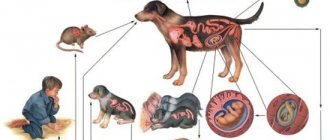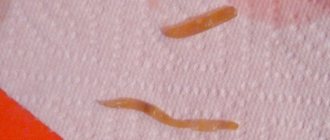Worms, or helminths, are parasitic worms that live primarily in the intestines of people and animals, but they can also settle in the liver, lungs, organs of the genitourinary system, lymph nodes, lymphatic and blood vessels, the brain, and so on. Parasitic worms feed and reproduce directly inside a living organism. According to the World Health Organization, about 4 billion people on the planet are infected with parasitic diseases. A person can become infected with 200 types of helminths. Pinworms are most often found in children, and diphyllobothriasis is diagnosed in lovers of raw fish and seafood.
According to research, helminthic infestation can provoke the development of various diseases that, at first glance, are not related to helminthiasis. There is even a theory that the activity of worms can stimulate the malignancy of some tissues.
The disease caused by helminths can be asymptomatic or disguised as liver or gall bladder diseases. A person, not knowing about the infection, may take drugs for other purposes. It is important not to be afraid to consult a doctor for help and ask disturbing questions about this sensitive topic. Diagnosis of worms in humans is carried out using different methods. Read more about each in the proposed article.
Causes
Worms in the intestines are transmitted mainly through the fecal-oral route, that is, in order to become infected, you must ingest parasite eggs or worm larvae. An unpleasant feature of this invasion is that some types of helminths in children and adults remain viable for a long time outside the host’s body (for example, in water, in soil).
Infection with worms
The parasite eggs that adults lay there remain infectious for several months. This feature leads to the fact that some types of worms in children and adults spread very widely.
The main routes of infection are as follows:
- Infection through drinking untreated water, which can be in a well, a natural reservoir, or even flowing from a tap. Almost all intestinal parasites in humans survive and multiply in water for a long time, so it is better to drink bottled water. In areas with unfavorable sanitary conditions, the water in the well can only be used after prolonged boiling;
- The appearance of a worm in a baby’s bottom can occur as a result of eating poorly washed vegetables. If manure that was infected with worms was used to fertilize the soil, then their larvae, eggs and adults appear and survive for a long time in the soil. Together with soil particles, the eggs fall on the vegetables. If such vegetables are poorly washed, they will enter the host’s body, causing helminthic infestation in humans;
- Bloating and other characteristic symptoms of infestation may occur after eating contaminated meat, fish or poultry. If an animal, bird or fish suffered from helminthic infestation during its lifetime, then its meat is most likely also infected, while parasites (for example, fish) easily take root in the human body. You can get rid of them only as a result of careful and prolonged temperature treatment of meat (boiling or frying at maximum temperatures). You can also defeat the invasion by freezing. But since most modern household freezers are capable of producing a maximum temperature of about 8 degrees, you need to keep meat, fish or poultry there for at least a week;
- Signs of worm infection in a person may also appear after contact with a pet. Dogs and cats that walk outside almost always have worms in their stomachs (domestic cats are usually not infected). When performing hygiene procedures, the animal spreads worm eggs from the anus throughout the fur. If you kiss such an animal or do not wash your hands after contact with it, you can get worms in the human body, since animal infestations take root and multiply in the human body;
- A person may notice bloating and other signs of the presence of helminths even after swimming in an infected body of water. This is a fairly rare method, but infection is possible;
- Transmission of helminthiasis in humans from one individual to another occurs through surfaces, towels, and linen. Eggs and larvae move to the surface or tissue from the skin of an infected person, and from there they migrate to the skin of a healthy person when touched. After this, there is a possibility of them getting into the oral cavity of a healthy person and developing infection.
It is worth remembering that many types of intestinal parasites are common in children's groups. This happens because many children are not too concerned about hygiene and many surfaces in kindergartens are covered with helminth eggs, a photo of which is presented below, even if only one child was initially sick.
For this reason, the primary task of parents is to explain to the child that all types of worms in humans are dangerous and can survive on the skin of the hands and enter the mouth. For this reason, it is important to maintain hygiene. A video about the spread of worms in women, men and children and the characteristics of their development is located at the end of the material.
How do you get infected with worms?
Everyone knows that infection with worms occurs through dirty hands. However, parasites can also enter the body through food. Everything we eat may contain eggs, cysts or larvae of parasites: meat; fish and caviar; vegetables, fruits, berries. Even bread, if you took it from an open tray. Parsley and dill have been found to preserve worm eggs after you have washed them. Flies, cockroaches, and fleas can be carriers and distributors of helminthic infestation. Worms can penetrate the skin when you bathe, come into contact with the ground, or through insect bites. Animals living with us in the house - dogs, cats, mice, pigs, birds - can cause infection with worm eggs. Worm eggs from dried feces can stick and spread with dust particles that we inhale.
Localization
Some people who suspect they have an infestation are interested in where in the human body are worms located? Although it is traditionally believed that worms in the human body are found in the intestines, this is not entirely true.
Almost all types of helminths in humans can develop in many organs and systems, which is due to the peculiarities of their migration, when larvae hatching from eggs in the intestines enter the blood and spread with it throughout the body.
They enter the human body through the mouth, but their manifestation can occur in the following places:
- Subcutaneous parasites are a not very common type of tropical parasite that is carried by insects (tsetse flies, specific tropical mites, etc.). Parasites under the skin are almost never found in the middle zone, but there is a risk of contracting them during a tourist trip. Such parasites are localized under the skin only in the initial stages of their life cycle, after which they can move into the muscles;
- A common place where localization is observed in women is the vagina, uterus. They can crawl there from the anus or infect the reproductive system at the migratory stage (see Worms in the human genitals);
- Worms in the ears of a child or an adult also occur because the larvae often infect the ENT organs (including the throat);
- Many worms choose the digestive system and intestines as their localization site (see Worms in the intestines). There they have enough nutrition (blood and serum) and oxygen to maintain normal life functions. Treatment for intestinal parasites is usually easier than for others. But even if they were initially in a person’s stomach, over time they can affect other organs;
- Signs of worms in the lungs can be confused with the characteristic symptoms of pleurisy or pneumonia. However, this is a common location for worms, so it is important to diagnose their presence in time;
- If parasites infest the brain, damage to the nervous system occurs. May manifest as convulsions, irritability, causeless anxiety, etc.;
- If worms in people manifest themselves in the heart, then tachycardia, rhythm disturbances, and more are possible. In especially severe cases, heart failure develops;
- Helminths are also common in the liver, since it is there that they enter primarily from the intestine through the portal vein (see Worms in the liver).
As can be seen from what is written above, patients who are wondering where worms live in humans must take into account not only the type of invasion, but also the stage of infection.
Types of worms in humans
Recognition of helminth representatives occurs on the basis of general characteristic signs and forms of behavior, life cycle and developmental characteristics. It also takes into account how worms manifest themselves in humans, how long they live in the body and what diseases they provoke.
Doctors can detect the presence of the following types of worms in the body:
- nematode, roundworm. The life cycle does not exceed 40 years; they parasitize in the intestines. May affect the respiratory system and stomach. Representatives: pinworms, roundworms, whipworms;
- tape parasites. They can live in the intestines and migrate throughout the body for about 20 years. Large sizes reach 8-10 meters. Individuals of bovine and pork tapeworms, tapeworms;
- flukes, trematodes. They appear in the internal organs and subcutaneous tissues. It moves throughout all organs and can become life-threatening.
Each of the above groups has representatives that are most often found in people.
And each of them poses a huge threat to the health and full functioning of the body:
- roundworm Causes: appendicitis, jaundice, inflammation of the bile ducts;
- pinworm. Complications: gastritis, allergic reactions, nervous disorders;
- whipworm Dysentery and rectal prolapse are observed;
- Toxocara. Decreased vision, bronchitis, necrosis of the pancreas, liver, kidneys, disruption of brain function;
- echinococcus. The parasite is dangerous due to anaphylactic shock, urticaria, liver enlargement, the appearance of cysts, and death;
- Trichinella. Causes the formation of infiltrate, affects the heart, brain;
- Giardia. Consequences: anemia, gastritis, Quincke's edema, pancreatitis;
- hookworms. Causes intestinal dysfunction;
- wide tape. Promotes anemia, hypovitaminosis, necrosis of intestinal tissue, damage to the spinal cord;
- filariae. Diseases: conjunctivitis, lymphadenitis, asthma, abscesses; pulmonary flukes. They provoke enteritis, bronchitis, fever, meningitis, tachycardia.
These are just a few representatives whose presence can be heard quite often. There are worms that are less harmful, but still dangerous. Therefore, there is a need to study them within the laboratory.
Complications
It is important to know what worms lead to, and what will happen if you do not treat them? Worms cause general intoxication of the body, which can be very severe.
Symptoms of an allergic nature also appear, as the immune system produces histamines in order to protect itself from foreign invasion. At the same time, you need to remember what an allergic rash with helminths looks like - these are small pink spots, sometimes hives, itching is usually absent.
Both when localized in the liver and when located in other organs, a tapeworm in humans or another parasite causes damage to the mucosa and local inflammatory processes of a small area.
As a result, an abscess may occur (in the case of the liver, with pus breaking into the abdominal cavity and blood poisoning if left untreated).
Both with damage to the bronchi and lungs, a cough often appears. Bronchitis, pleurisy or pneumonia then develop and must be treated with antibiotics, despite the fact that this is a reaction to invasion.
When parasites are localized in the vagina, exacerbations of chronic diseases and microflora disturbances may occur. It is believed that this phenomenon can lead to infertility.
Symptoms
Symptoms of worms in humans are varied, but are characteristic of almost all types of parasites. However, chronic and acute infestations may have different symptoms in adults. In case of acute infection, the following signs of the disease are characteristic:
- Elevated temperature with normal general condition (up to 38 degrees);
- Chills and skin symptoms (rashes) consistent with fever;
- When the larvae are localized in the lungs or bronchi, symptoms in the body are expressed by coughing;
- Inflammatory processes are signs of the presence of worms in the human body, which is why the lymph nodes become enlarged;
- Worms and allergies in an individual are connected, therefore there may be signs of the appearance of worms in a person in the form of rashes and allergic reactions (see Skin rashes due to worms).
But most often the symptoms of the presence of worms in humans are intestinal, since this is where the parasite is most often localized. These are symptoms of worm infection in an individual, such as:
- Stool disorders - constipation or diarrhea, sometimes mixed with blood;
- The first symptoms of worms are loss of appetite, nausea, aversion to certain types of foods, which over time leads to weight loss;
- The first signs of worms in adults can also be represented by flatulence and bloating;
- Over time, pain in the abdomen and stomach develops, independent of food intake, periodic or constant;
- With worms, a person develops symptoms of general intoxication - pallor, drowsiness, chronic fatigue, etc.
Specific symptoms in adults and children are caused by skin parasites. A sign of worms is numbness of the limbs, tingling in the skin, headache, dizziness, and much less often - fever. In any case, the incubation period of worms in humans is quite long and can take from several weeks to several months.
For this reason, the first signs of worms in humans may not appear soon. And since almost all symptoms in a person of the presence of worms can indicate other diseases, often if a person has worms, this becomes clear only when they are excreted in the feces.
Signs of worms in children
If worms appear in children, they must be identified immediately in order to begin urgent treatment.
Worms show much more severe and dangerous symptoms in small children and newborns. Not yet having sufficient immunity and protective protein cells, children are often susceptible to more complex consequences of parasites in the body:
- intestinal dysfunction, dysbacteriosis;
- bloating, flatulence;
- dermatitis, urticaria;
- involuntary urination or urinary incontinence;
- respiratory tract diseases. Bronchitis, pneumonia, asthma;
- girls experience inflammation of the genital external and internal organs
- vomiting, nausea;
- itching and burning near the anus;
- severe aching abdominal pain and colic;
- lack of sleep;
- nervousness,
- In newborns, death or developmental delays are possible.
It is quite difficult to identify worms on your own, and many parents do not think about how to find out about them. By self-medicating their children, they provoke the spread of parasites throughout the children’s body. The consequences in such cases are unpredictable.
Diagnostics
Even knowing how worms manifest themselves, you may not notice their appearance. Some types of worms do not appear for a long time, and diagnosis of worms in humans cannot be carried out at home. In laboratories, the following methods are used to help determine if there are worms, symptoms and treatment of which are discussed in this article:
- General blood analysis. There may be worms if there are deviations in it. This looks like severe anemia - a significant decrease in iron and hemoglobin levels. It occurs as a result of the fact that worms in humans cause local bleeding, constantly damage the mucous membranes, and they are also parasites that feed directly on blood;
- If worms are in the intestines, then their waste products will be present in the stool. What signs of worms are visible in an individual’s stool? These are eggs, larvae or even adult parasites. Although, if you know what worms look like in humans, you can identify adult worms in the stool yourself;
- Regardless of where a person’s worms come from and what type of worms a person has (protozoa, roundworms, tapeworms), antibodies to them appear in the blood. This is due to the fact that as soon as a person has worms, the immune system regards them as a foreign invasion and tries to protect itself from it by producing antibodies. This method helps to establish what types of worms are present and what symptoms to expect, since each infestation produces its own antibodies.
Read more in the article - What test should I take for worms?
The latter diagnostic method is especially good because it allows you to find out about worms at an early stage, identify the types of worms and find out how to treat worms in humans.
Treatment
Nemozol
Some of those patients who are interested in what human worms look like and how they enter the body also want to know how to cure them in an individual. The official drug treatment regimen for worms in adults involves a single dose of an anthelmintic drug that affects the entire body when a person has worms.
It is also advisable to repeat the course of treatment in adults 2 to 3 weeks after the drugs were used for the first time. Small and large infestations need to be poisoned twice to completely get rid of the larvae. You can treat worms in adults with Piperazine, Pyrantel, Nemozol, Vermox, etc.
A different treatment is suggested if children have worms. Since the drugs are toxic, treatment in adults has a negative effect on the liver. For children, medications are prescribed that can be taken in a short course (several times), which reduces the load on the liver.
Some of those who are wondering how to treat worms in an individual opt for traditional methods of struggle, when worms in an adult or child are eliminated using natural means.
It is believed that a mixture of ground pumpkin seeds and honey in a one to one ratio is effective against worms if consumed daily in a tablespoon.
Effective treatment is carried out using enemas of garlic-milk solution. You can also be treated for helminths in the intestines by drinking a similar solution. If a person has worms, symptoms will begin to appear milder within a week.
Folk remedies against parasites
When people talk about traditional methods of treating worms, we can think of pumpkin seeds. They can be given to adults and children. According to doctors, they contain cucurbitins, which can destroy parasites. But don’t think that pumpkin seeds can completely cure you of helminths.
Those parasites that are inside the human body pose a great danger. If it is not seriously treated and not observed by a doctor, then there is a risk of complications (worms multiply very quickly). Parasites are able to penetrate the pancreas, gall bladder, and their ducts. Worms can cause anemia (decreased hemoglobin levels) and intestinal obstruction. Therefore, you need to see a doctor as soon as possible and get a stool test for worms.
Prevention
Knowing what causes worms and where pinworms come from, you can determine a list of rules that should be followed in order to protect yourself from worms in humans. In order not to wonder “do I have worms”, you should do the following:
- Wash vegetables and fruits thoroughly;
- Thoroughly boil or fry the meat, you can also freeze it for a long time;
- For drinking, use only bottled or purified water;
- Limit contact with pets and provide them with regular prevention of helminthic infestation;
- Wash your hands regularly, especially after being in public places.
If an infection is suspected, it is recommended to regularly inspect the stool for the presence of helminths.










